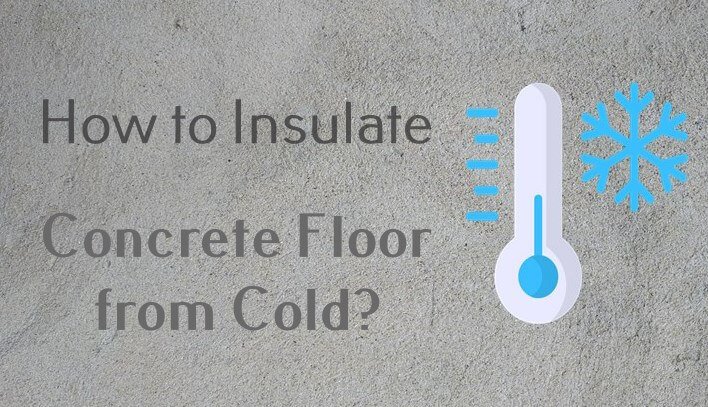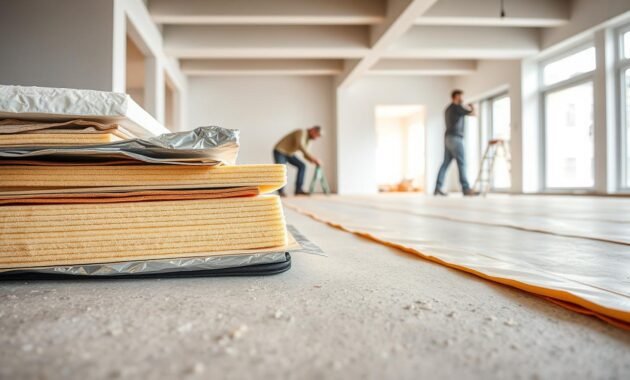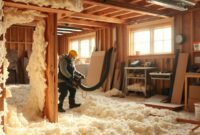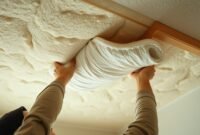Cold concrete floors can make your home feel like an ice rink. Basements and ground-level rooms often get too chilly. This makes your heating system work harder and your bills go up.
It’s time to learn how to keep your concrete floors warm. This guide will show you easy and affordable ways to do it. You’ll find out how to make your floors cozy and save on energy.

Understanding Heat Loss Through Concrete Floors
Uninsulated concrete floors can quietly waste energy in your home. As a homeowner, I’ve found that these floors are great at spreading cold. This makes your home feel chilly and raises your energy bills.
To insulate cold floor areas, knowing about heat transfer is key. Concrete, being dense, easily moves temperature. This means it can quickly take warmth from your living spaces.
Read also: How to Insulate Windows to Keep Heat Out?
Impact on Energy Bills
Poorly insulated concrete floors can really up your heating costs. Studies show that uninsulated basement and ground floors can lose up to 25% of your home’s heat. The right insulation can help you:
- Lower your monthly heating bills
- Make your home more comfortable
- Stop cold spots
- Boost your home’s energy efficiency
Common Cold Spots in Basements
Basements often have uneven temperatures. The coldest spots are near exterior walls, floor corners, and around support columns. These areas need extra care when insulating.
Heat Transfer Mechanics in Concrete
Concrete moves heat through thermal conductivity. Its dense nature lets temperature flow fast. This means cold ground can quickly cool your home. Insulation acts as a barrier, slowing this heat transfer. It keeps your home warmer and saves energy.
Benefits of Insulating Concrete Floors
Insulating concrete floors brings many benefits to homeowners. It’s not just about keeping your home warm. It’s also a smart choice for your home’s comfort and energy use.
Read also: How to Insulate a Concrete Floor Properly
Here are the main advantages of insulating a concrete floor slab:
- Energy Cost Savings: Reduces heating expenses by up to 30%
- Enhanced Indoor Comfort: Eliminates cold floor surfaces
- Moisture Protection: Prevents water vapor penetration
- Improved Home Value: Increases overall property efficiency
One big plus is saving on energy costs. Without insulation, concrete floors waste a lot of heat. This makes your heating system work harder and raises your bills. Good insulation keeps warmth in during winter and cool air in during summer.
Another key benefit is controlling moisture. Concrete can absorb and move moisture, which can cause mold and damage. Insulation stops this, keeping your home dry and healthy.
Insulating your concrete floor is a wise investment. It improves your comfort, saves energy, and protects your home for years to come.
Essential Materials and Tools for Floor Insulation
Choosing the right materials and tools is key for insulating a concrete slab floor. Knowing what insulation to use helps fight cold floors and boosts your home’s energy efficiency.
Insulation Types and R-Values
There are various insulation materials for concrete floors, each with its own thermal protection level. It’s important to pick the right R-value for your needs.
- Rigid Foam Boards: Provide R-values between R5 and R10
- Mineral Wool: Offers R-values from R4 to R8
- Extruded Polystyrene (XPS): Ranges from R5 to R15
Required Tools List
Before starting your insulation project, collect these essential tools:
- Tape measure
- Utility knife
- Caulking gun
- Level
- Protective cutting surface
- Chalk line
Safety Equipment Needed
Protecting yourself is vital when insulating a concrete slab floor. Ensure you have:
- Safety glasses
- Work gloves
- Dust mask
- Knee pads
- Long-sleeved shirt
By choosing the right insulation and preparing with the correct tools, you’re ready to tackle your insulation project safely and effectively.
How to Insulate Concrete Floor from Cold

Insulating a concrete floor from cold is key to keeping your home warm and saving on energy. To insulate a concrete floor, you need to follow a few important steps. These steps can turn a cold basement or ground-level area into a cozy space.
Let’s explore the essential steps to insulate your concrete basement floor. This will help make your living space warmer. You’ll need to prepare well and use the right materials to stop cold from getting in.
- Clean the concrete surface thoroughly
- Check for moisture and seal any cracks
- Install a vapor barrier to prevent moisture intrusion
- Select appropriate insulation materials
- Apply insulation boards or panels
- Create a protective subfloor layer
To start, prepare the concrete floor. Remove dirt, fix cracks, and make sure it’s dry. A moisture-resistant barrier is vital to avoid dampness or mold.
For the best insulation, use rigid foam insulation boards. They block cold well and can be cut to fit your floor. Make sure to seal the boards tightly and cover the whole floor.
The last step is to add a subfloor and your chosen floor covering. This layer adds more warmth and makes walking more comfortable.
Types of Concrete Floor Insulation Solutions
Choosing the right insulation for a cold basement or ground-level space can make it cozy. As a homeowner, I’ve looked into different insulation methods. These can greatly improve your home’s comfort and lower energy costs.
Rigid Foam Boards: A Top Insulation Choice
Rigid foam boards are a favorite for insulating concrete floors. They are lightweight, offer great thermal resistance, and protect against moisture. Here are some benefits:
- High R-value per inch of thickness
- Excellent moisture barrier properties
- Easy to cut and install
- Minimal impact on ceiling height
Radiant Barrier Systems: Advanced Heating Solution
Radiant barrier systems are a modern way to insulate concrete floors. They reflect heat back into the room, making it more comfortable. This also cuts down on energy use.
Sleeper System Options: Versatile Insulation Method
Sleeper systems offer a flexible way to insulate concrete floors. They create a raised subfloor for more insulation and space for wiring or plumbing. They’re great for basements or rooms with moisture issues.
When picking insulation, think about moisture, ceiling height, and your room’s needs. Each option has its own advantages. They can significantly boost your home’s comfort and energy efficiency.
Read also: What Is the Difference Between Faced And Unfaced Insulation
Preparing the Concrete Surface
Learning to insulate a concrete floor from cold starts with surface preparation. A well-prepared slab is key for effective insulation and lasting thermal protection.
Let’s explore the important steps for a successful insulation project. Preparing the concrete surface is more than just cleaning. It’s about making the floor ready for maximum energy efficiency.
- Thoroughly clean the concrete surface, removing all dirt, dust, and debris
- Inspect for existing cracks or structural damage
- Repair any surface imperfections using concrete patching compound
- Check for moisture levels using a specialized concrete moisture meter
- Level the surface using self-leveling compound if necessary
Managing moisture is vital for effective insulation. Use a professional-grade moisture barrier to stop water infiltration. This is key to keeping your insulation working well.
Professional tip: Always let the concrete dry fully after repairs before adding insulation. Hurrying can cause moisture problems later.
By carefully preparing your concrete, you set up your insulation for success. This ensures better thermal performance and saves energy in the long run.
Vapor Barriers and Moisture Protection
Protecting against moisture is key when insulating a cold floor. Vapor barriers are essential to stop water damage and keep your insulation working well.
Moisture can ruin your efforts to insulate a concrete floor. Without the right protection, water vapor can damage your floor. This can lead to mold and make your insulation less effective.
Types of Vapor Barriers
There are several good vapor barrier options for your concrete floor:
- 6-mil polyethylene sheeting
- Specialized plastic membranes
- Liquid-applied moisture barriers
- Reinforced plastic sheets
Installation Techniques
Installing vapor barriers correctly is important. Here are the main steps:
- Clean the concrete surface thoroughly
- Repair any cracks or imperfections
- Ensure the surface is completely dry
- Overlap barrier edges by at least 6 inches
- Seal all seams with specialized tape
Choosing the right vapor barrier and installing it right can stop moisture problems. This will help your insulation last longer.
Installing Radiant Floor Heating Systems

Radiant heating systems change how we think about home comfort. As a homeowner, I’ve found radiant floor heating to be very efficient. It heats your space evenly from the floor up.
When looking at radiant heating, you have two main choices:
- Electric radiant heating mats
- Hydronic (water-based) radiant heating systems
Electric radiant heating is great for small areas like bathrooms or kitchens. You lay heating mats under your floor. They heat up through electrical resistance.
| Heating System Type | Installation Difficulty | Cost Efficiency | Best Room Application |
|---|---|---|---|
| Electric Radiant Heating | Easy | Moderate | Small spaces |
| Hydronic Radiant Heating | Complex | High | Entire home |
For bigger areas, hydronic radiant heating is better. It uses warm water in pipes under the floor. This system is very efficient and keeps your space warm. You’ll need a pro for this because it’s complex.
Before getting a radiant heating system, talk to a pro. They can look at your home and figure out what you need. They’ll pick the best system for you, so you’re comfortable and save on energy.
Flooring Options Over Insulated Concrete
Choosing the right flooring is key after insulating your basement floor. The right choice can make a cold concrete floor warm and inviting. It can also boost your home’s comfort and value.
Several flooring options stand out for their performance and look. Each material has unique qualities that can match your insulated basement floor.
Compatible Floor Coverings
Here are the top flooring choices for insulated concrete surfaces:
- Luxury Vinyl Planks (LVP): Waterproof and durable
- Ceramic Tiles: Excellent moisture resistance
- Laminate Flooring: Budget-friendly option
- Engineered Hardwood: Adds warmth and elegance
Installation Methods
Choosing the right installation method is important. Different flooring types need specific approaches:
| Flooring Type | Installation Method | Moisture Resistance |
|---|---|---|
| Luxury Vinyl Planks | Floating or Click-Lock | High |
| Ceramic Tiles | Mortar and Grout | Excellent |
| Laminate | Floating Installation | Moderate |
| Engineered Hardwood | Glue-Down or Floating | Low |
It’s wise to consult a professional for proper installation. This will ensure your basement floor insulation works well.
Common Mistakes to Avoid
Many homeowners make mistakes when insulating their concrete basement floors. These errors can cost you time, money, and cause frustration. Knowing what to avoid can help you avoid these problems.
Insulating a concrete basement floor requires careful planning and attention to detail. Here are the most common errors to watch out for:
- Skipping moisture assessment before insulation
- Choosing incorrect insulation materials
- Neglecting vapor barrier installation
- Inadequate surface preparation
- Overlooking possible air leak points
Let’s look at the biggest mistakes people make when insulating their floors:
| Mistake | Potential Consequences | Prevention Strategy |
|---|---|---|
| Ignoring Moisture Issues | Mold growth, structural damage | Conduct thorough moisture testing |
| Improper Vapor Barrier | Condensation, insulation degradation | Use appropriate vapor barrier material |
| Incorrect Insulation Type | Reduced thermal efficiency | Select insulation matching R-value requirements |
Professional tip: Always check your concrete surface before starting insulation. Fix cracks, address moisture, and make sure it’s clean and dry for the best results.
By avoiding these common mistakes, you can create a more effective insulation solution for your basement floor. Proper preparation and choosing the right materials are essential for success.
Conclusion
Insulating a concrete floor is more than a home project—it’s a smart investment. It makes your home more comfortable and saves energy. By learning the best ways to insulate, you can turn cold spaces into cozy ones.
In this guide, I’ve covered everything you need to know about insulating concrete floors. You now know how to pick the right materials and install them correctly. This will help you save on energy costs and make your home more comfortable.
The right insulation for your concrete floor depends on your needs and budget. You might choose rigid foam boards, radiant barriers, or sleeper systems. The most important thing is to prepare well and install accurately. Don’t forget to use moisture protection and vapor barriers to avoid damage.
With the skills you’ve learned, your home will be better at keeping warm and dry. Insulating your floors correctly is a smart move. It makes your home more comfortable and energy-efficient, lasting for many years.


